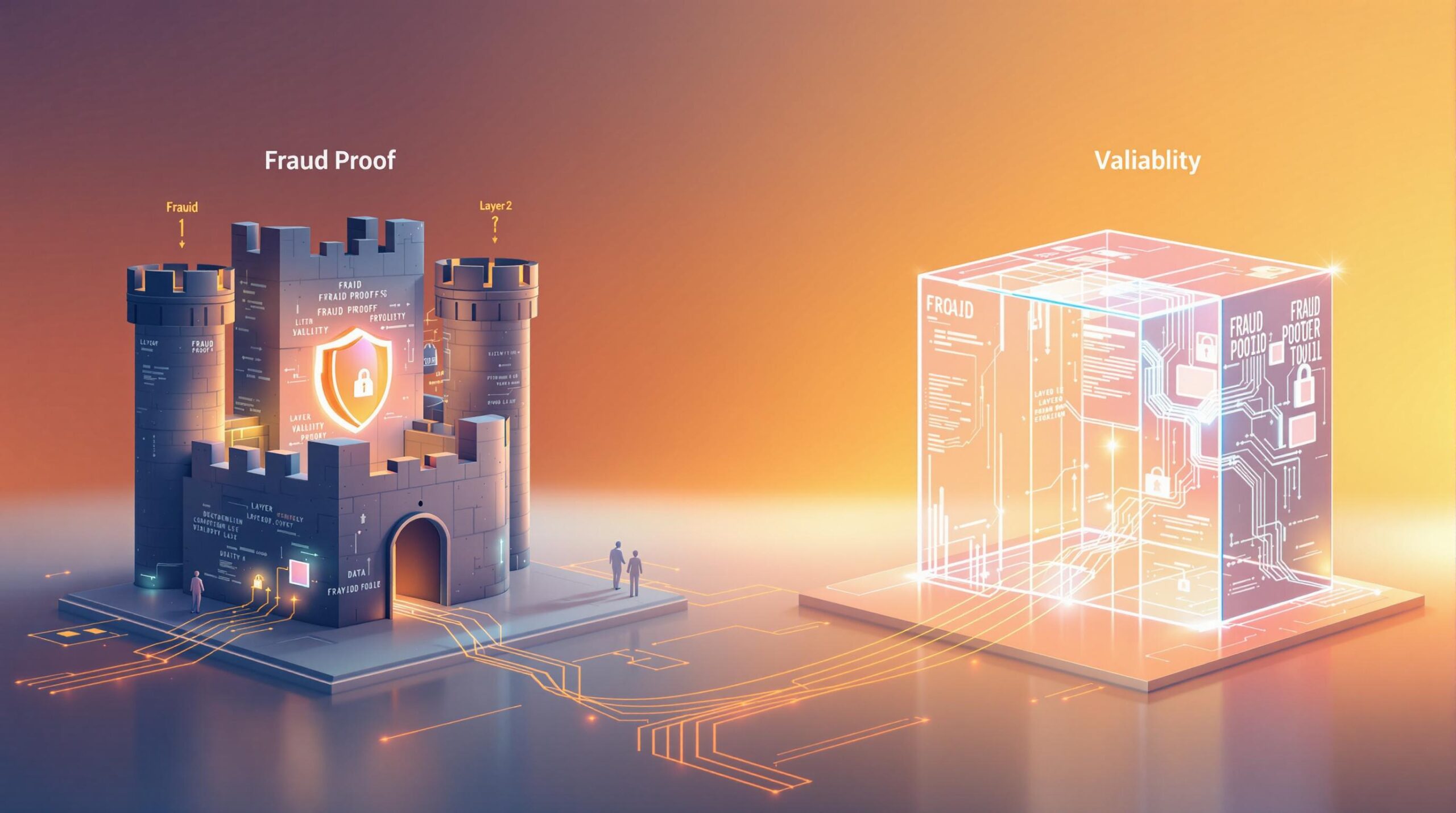Layer-2 solutions improve blockchain speed and cut costs by processing transactions off-chain and anchoring them back to Layer-1 (e.g., Ethereum). The two main methods for verifying these transactions are fraud proofs and validity proofs. Here’s a quick breakdown:
- Fraud Proofs: Assume transactions are valid unless challenged. They use a challenge period for disputes, which slows finality but reduces costs.
- Validity Proofs: Use cryptographic proofs (e.g., zk-SNARKs) to instantly verify transactions on-chain, ensuring immediate and secure finality.
Quick Comparison
| Feature | Fraud Proofs | Validity Proofs |
|---|---|---|
| Finality Speed | Slower (challenge period needed) | Instant |
| Security | Relies on dispute mechanism | Cryptographic verification |
| Cost Efficiency | Lower computational costs | Higher due to cryptography |
| Use Case | Optimistic rollups | High-frequency trading, DEXs |
For developers, the choice depends on whether speed or cost is the priority. Hybrid systems often combine both to balance security, speed, and efficiency.
Fraud Proofs Explained
Fraud Proof Basics
Fraud proofs play a critical role in securing Layer-2 scaling solutions by verifying flagged transactions. They operate on the assumption that all transactions are valid unless someone raises a challenge.
This system allows any participant to question suspicious transactions directly on-chain. It ensures security while supporting high-speed, off-chain trading.
These concepts provide the foundation for diving into the mechanics discussed in the next section.
Fraud Proof Mechanics
The process involves a structured challenge-response sequence:
-
Transaction Submission
A participant identifies a potentially problematic transaction and submits evidence of a protocol violation. -
Challenge Period
A designated waiting period is triggered, giving others a chance to contest the transaction. -
Dispute Resolution
If challenged, the main blockchain re-executes the computation to verify the claim. If the challenge is valid, the transaction is reversed.
Core System Elements
Fraud proofs depend on several essential components to function effectively:
- Challenge Windows: These are specific timeframes during which transactions can be disputed.
- Verification Logic: Smart contracts on the blockchain handle the verification process for flagged transactions.
This system allows platforms to process thousands of trades off-chain while retaining the ability to challenge and verify questionable activities. This design supports high-speed order matching and leveraged trading without sacrificing security.
One of the major benefits of fraud proofs is their balance between efficiency and security. By keeping most computations off-chain and only using on-chain verification for disputed transactions, they achieve significant scalability while upholding security principles.
| Component | Purpose | Impact on DEX Operations |
|---|---|---|
| Challenge Period | Provides time for detecting fraud | Affects how quickly settlements finalize |
| On-chain Verification | Ensures disputes are resolved fairly | Protects transaction integrity |
Validity Proofs Explained
Validity Proof Basics
Validity proofs use advanced cryptography to verify transactions mathematically. This Layer-2 method ensures transactions are finalized on the main blockchain instantly, without any waiting periods.
How Validity Proofs Work
The process ensures transaction accuracy through these steps:
-
Batch Processing
Transactions are grouped together for cryptographic processing, creating a single proof of validity. -
Proof Generation
Using zero-knowledge protocols like zk-SNARKs or zk-STARKs, compact proofs are created to confirm that all transactions in the batch follow protocol rules. -
Main Chain Verification
The proof is sent to the main blockchain, where smart contracts validate it. Once verified, the transactions are finalized immediately.
Key Components of the System
| Component | Function | Security Benefit |
|---|---|---|
| Cryptographic Proofs | Verifies transaction validity | Removes the need for challenge periods |
| Verification Contracts | Validates proofs on-chain | Guarantees immediate finality |
| State Transition Logic | Sets rules for valid state changes | Blocks invalid state transitions |
Validity proofs stand out due to their ability to finalize transactions instantly while enhancing security. Unlike fraud proofs, which rely on challenge periods and can be exploited during that time, validity proofs confirm correctness immediately. This makes them ideal for scenarios like decentralized exchanges, where fast and secure transaction settlement is essential for traders.
Direct Comparison
Security Features
Fraud proofs and validity proofs take different approaches to securing Layer-2 transactions. Validity proofs rely on cryptographic methods to ensure transactions are final as soon as they’re confirmed. Once validated, the transaction is locked in and cannot be reversed. On the other hand, fraud proofs operate with a challenge period. During this time, any transaction can be disputed, allowing for potential corrections if something goes wrong. This creates a balance: validity proofs offer fast and definitive security, while fraud proofs provide flexibility to address disputes.
Speed and Scale
When it comes to speed, validity proofs excel. Transactions are confirmed almost instantly, making them ideal for activities like high-frequency trading, where every second counts. Fraud proofs, however, require waiting through the challenge period, which can slow things down and make real-time processing less practical. For high-performance platforms, the near-instant confirmation of validity proofs ensures smoother operations with minimal delays. These differences play a key role in shaping how these methods are implemented, which we’ll explore next.
sbb-itb-dd9e24a
Implementation Guide
Fraud Proof Applications
Fraud proofs are commonly used in optimistic rollups, where transactions are presumed valid unless someone challenges them. These proofs are ideal for systems where short delays are acceptable. The challenge period helps reduce computational costs but isn’t suitable for scenarios requiring instant settlements.
Validity Proof Applications
Validity proofs use cryptographic methods to verify transactions immediately. This makes them a great fit for platforms that need quick transaction confirmations, especially in high-performance environments.
Combined Systems
Layer-2 solutions are starting to combine both approaches to take advantage of their unique strengths. For instance, validity proofs can handle time-sensitive operations, while fraud proofs work well for transactions that can afford minor delays. This flexible approach ensures that each transaction gets the right level of verification, balancing speed and security effectively in Layer-2 systems.
Related video from YouTube
Conclusion
We’ve explored the distinct but complementary roles of fraud and validity proofs in improving Layer-2 scaling. Let’s recap the key takeaways and look ahead.
Main Points
Fraud proofs offer a cost-efficient way to ensure security by using a challenge period, making them suitable for applications that can handle slight delays. On the other hand, validity proofs provide instant, cryptographically-secured finality, making them ideal for scenarios like high-stakes trading. Together, these methods address different needs, as outlined earlier.
Next Steps
Layer-2 platforms are increasingly moving toward hybrid solutions that combine both proof systems. This approach allows different transaction types on the same platform to benefit from tailored verification methods. Developers are focusing on reducing validation costs and improving challenge mechanisms to boost both security and performance.
Selection Guide
When deciding between proof systems, consider these factors:
- Transaction Speed: If instant finality is a priority, validity proofs are a better fit.
- Cost Efficiency: Fraud proofs work well for systems that can handle short delays.
- Security Requirements: Choose based on how quickly transactions need to be finalized.
For high-volume decentralized exchanges, a hybrid approach often strikes the right balance between fast settlements and strong security.











